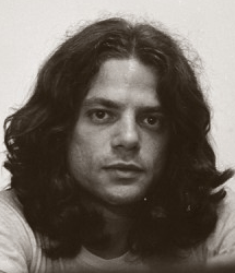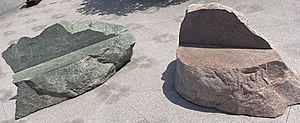Scott Burton facts for kids
Quick facts for kids
Scott Burton
|
|
|---|---|
 |
|
| Born | June 23, 1939 Greensboro, Alabama
|
| Died | December 29, 1989 (aged 50) New York City, New York, U.S.
|
| Education | Washington Workshop Center, Hans Hofmann School of Fine Arts |
| Alma mater |
|
| Known for | Public Sculpture |
Scott Burton (born June 23, 1939 – died December 29, 1989) was an American sculptor and performance artist. He was famous for his large furniture sculptures made from materials like granite and bronze.
Contents
Becoming an Artist: Scott Burton's Early Life and Education
Scott Burton was born in Greensboro, Alabama. When he was a child, his parents separated. He then moved to Washington, DC. with his mother.
Burton started his art journey in the mid-1950s at the Washington Workshop Center. He studied under Leon Berkowitz. Later, he went to the Hans Hofmann School of Fine Arts in Provincetown, Massachusetts. Between 1959 and 1962, Burton took classes at several universities. These included Goddard College, George Washington University, and Harvard University. He earned his bachelor's degree from Columbia University.
In 1963, Burton received his Master of Fine Arts degree. He earned it from New York University in New York City.
Scott Burton's Art Career: From Writing to Sculpture
In the 1960s, Burton became friends with painter John Button. Through Button, he met many people in New York's art, dance, and theater worlds. These included famous people like Edward Albee and Jerome Robbins.
Burton first tried to be a playwright. But in 1965, he started writing about art. In 1966, he joined ARTnews magazine. He became an editor there. He wrote a lot of art reviews in the late 1960s.
Performance Art and Early Sculptures

In 1969, Burton began making performance art. He took part in "Street Works" events. Throughout the 1970s, he was known as an art critic and performance artist. In 1972, he showed his Group Behavior Tableaux at the Whitney Museum of American Art. He also staged other performances at places like the Guggenheim and Documenta. These performances explored how people communicate without words. They also looked at how power works between people.
Burton started using furniture in his art around 1970. At first, furniture was part of his performances. Later, it became his main focus. He began making sculptures in 1972. His first show with sculptures was at the Whitney Biennial in 1975. After that, he had a solo show at Artists Space in New York City. Much of his early work used furniture he found and then changed slightly. For example, in 1972, he painted an old chair to look like bronze. In 1975, he had it cast in real bronze. This piece, Bronze Chair, was shown near Artists Space.
Through the rest of the 1970s, Burton continued to create performance art. He also made more and more sculptures. He became very interested in public art. Starting in 1979, he began making functional furniture that was also sculpture. He called it "pragmatic sculpture." These pieces were meant to blend into everyday life.
Furniture as Sculpture: Challenging Art Boundaries
In the 1980s, Burton became famous for his furniture sculptures. He also created large, useful art pieces for public spaces. His "tables" and "chairs" make people wonder if they are furniture or art. For example, Two-Part Chairs, Right Angle Version (a Pair), (1983-87) shows this idea. These granite chairs fit together. You can find them at the Western Washington University Public Sculpture Collection. The two parts of the chair support each other. Neither part can stand alone. Copper Pedestal Table (1981–83) is another example. It is in the collection of the Honolulu Museum of Art. It is both a minimalist sculpture and a table.
One of Burton's main goals was to break down art rules. He wanted to remove the line between fine art and useful design. Art historian Robert Rosenblum said Burton's work "destroyed the boundaries between furniture and sculpture." He also said it changed how we see other artists like Gerrit Rietveld and Brâncuși.
Sadly, many of Burton's important public art pieces are now at risk. Some have even been removed or destroyed. For example, the Atrium Furnishment for the AXA Equitable Center in New York was removed. Only the outside parts of that work remain. Some pieces have been shown in new ways to highlight the loss of Burton's art.
Scott Burton's Passing
Scott Burton passed away on December 29, 1989. He died in New York City due to health complications. He was survived by his partner, Jonathan Erlitz.
Notable Works in Public Collections
- Public Table (1978-1979), Princeton University Art Museum, Princeton, New Jersey
- Chair (1979), Allen Memorial Art Museum, Oberlin, Ohio
- Untitled (Red/Yellow/Blue Cube) (1979-1980), Museum of Contemporary Art, Los Angeles
- Pair of Rock Chairs (1980-1981), Museum of Modern Art, New York
- Aluminum Chair (conceived 1980-1981, fabricated 1981), Museum of Modern Art, New York
- Rock Chair (1981), Philadelphia Museum of Art
- Lava Rock Chair (1981-1982), Los Angeles County Museum of Art
- Asymmetrical Settee (conceived 1982, fabricated 1985-1986), Tate, London
- Pair of One Part Chairs (1983), Hessel Museum of Art, Center for Curatorial Studies, Bard College, Annandale-on-Hudson, New York
- Two-Part Chairs, Obtuse Angle (A Pair) (1983-1984), Walker Art Center, Minneapolis
- Pair of Two-Part Chairs, Obtuse Angle (1984), Whitney Museum of American Art, New York
- Untitled – half-size Maquette (c. 1985), Smithsonian American Art Museum, Smithsonian Institution, Washington, D.C.
- Seating for Eight (1985), Art Institute of Chicago
- Settee, Bench, and Balustrade (1985), List Visual Arts Center, Cambridge, Massachusetts
- Low Piece (Bench) (conceived 1985, fabricated 1986), Art Institute of Chicago
- Six-Part Seating (conceived 1985, fabricated 1998), National Gallery of Art, Washington, D.C.
- Sandstone Bench (1986), Des Moines Art Center, Iowa
- Three-Quarter Cube Bench (1986), Museum of Contemporary Art, Chicago
- Seat-Leg Table (conceived 1986, fabricated 1991), Walker Art Center, Minneapolis
- Two-Part Chaise Lounge (1986-1987), Philadelphia Museum of Art
- Settee (1986-1987), The Broad, Los Angeles
- Pair of Parallelogram Chairs (1987), Yale University Art Gallery, New Haven, Connecticut
- Two-Part Chairs, Right Angle Version (a Pair) (1987), Western Washington University Public Sculpture Collection, Bellingham
- Two-Part Bench (a pair) (conceived 1987, fabricated 1989), San Francisco Museum of Modern Art
- Rock Settee (1988), National Gallery of Art, Washington, D.C.
- Rock Settee (1988), National Gallery of Art, Washington, D.C.
- Bench and Table (conceived 1988, fabricated 1991), Smart Museum of Art, Chicago
- Pair of Steel Chairs (1987-1989), Anderson Collection, Stanford University, Stanford, California
- Bench and Table (1988-1989), Carnegie Museum of Art, Pittsburgh
- Bench and Table (1988-1989), Middlebury College Museum of Art, Middlebury, Vermont
- Perforated Metal Settee and Perforated Metal Chairs (1988-1989), Museum of Modern Art, New York
- Bench and Table (conceived 1989, fabricated 1990), The Broad, Los Angeles
See also
- Six-Part Seating


